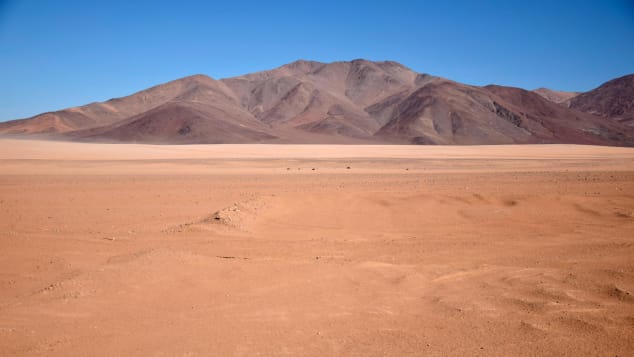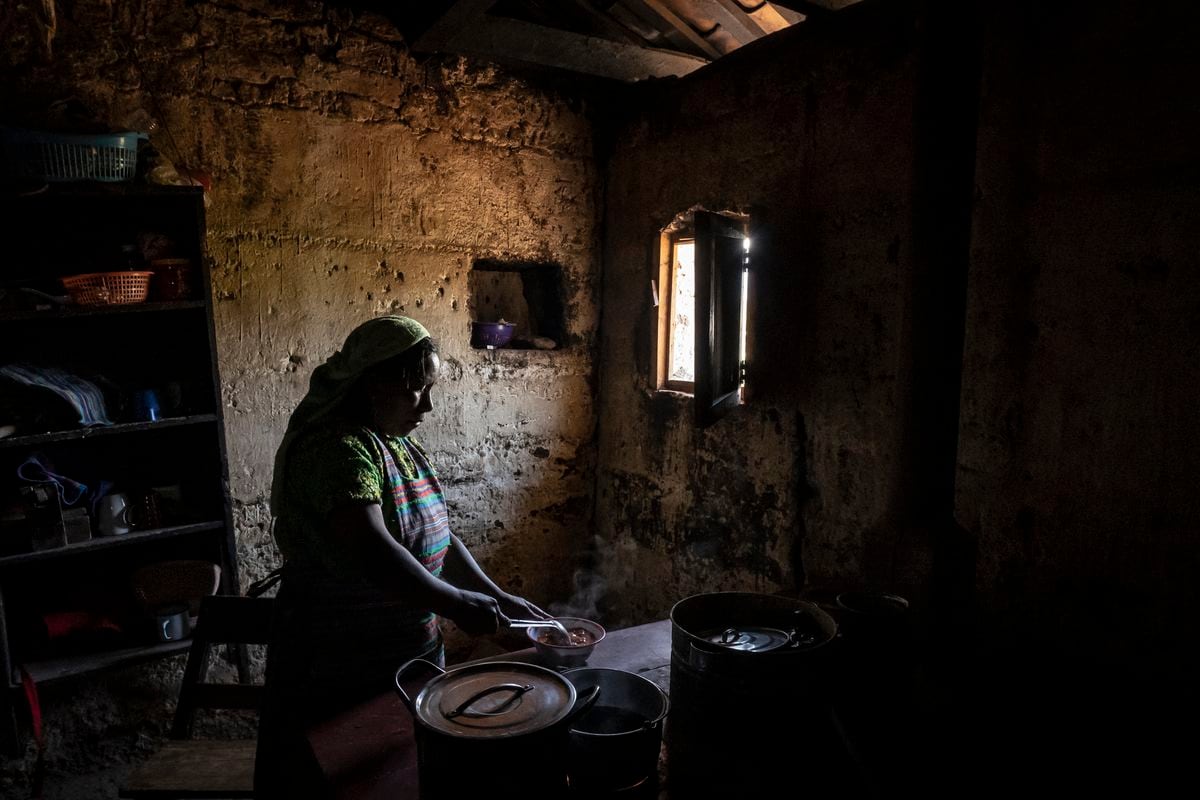Visit Mars ... without leaving Earth 1:36
(CNN) -
Ethereal images of the Mars Perseverance rover have ignited the internet since NASA's latest high-tech robot landed on the Red Planet on February 18.
The photos, posted on NASA's website, depict a dry landscape of lifeless orange-brown soil with rugged, rocky hills snaking across the horizon.
Although decidedly otherworldly, there is also something surprisingly familiar about them.
Perhaps that's because the images look a lot like a place here on Earth, a remote desert in Chile that NASA itself has spent time and money exploring.
"It can be argued whether the Dry Valleys in Antarctica or the north-central part of Atacama is the driest place on Earth, but some parts of the Atacama only receive rain every 20 or even 100 years," says Brian Glass, principal investigator of the Atacama Rover Astrobiology Drilling Studies (ARADS; 2016-2019), which used the Atacama Desert to test tools and techniques for future missions to Mars.
Because the Atacama is such a dead and desolate place, NASA has come to see it as the perfect analog to Mars on Earth, testing rovers here regularly since 1997. The latter have used prototype instruments to try to detect life, "because if we can't do it in one of the deadliest places on Earth, we don't have to take it to Mars, "explains Glass.
NASA's ARADS team works with its prototype Mars rover in Chile's Atacama desert in 2018. (NASA / CampoAlto / Victor Robles)
Atacama is a 1,600 km thin strip of desert in the northern half of Chile between the Pacific Ocean, to the west, and the Andes, to the east.
Glass says that to understand how lifeless certain parts are, you can think in terms of the organic signal (that is, life) in the background noise.
advertising
"The signal, even in Mojave and remote parts of the US continent, is still pretty strong," he says.
«You can still see bushes, cacti, microorganisms, scorpions, insects;
there is still an ecosystem.
In contrast, in the hyper-arid Atacama, "you could literally fall, cut your arm on a stone and not worry about getting an infection because there are no local pathogens," he said.
What is it like to visit a place that NASA compares to Mars on Earth?
Like Mars, the Atacama has an extreme topography with vast salt flats and towering volcanoes, including the tallest asset on earth.
It also has some of the darkest skies on our planet and the largest astronomical facilities.
With Chile vaccinating its population faster than anywhere else in the Americas (including the United States), the otherworldly Atacama will likely be one of the first places in the region to welcome international visitors.
So if those dramatic Perseverance images have sparked new interest on Mars, the best thing to do is a ground flight away.
LOOK
: What you should know about the new restrictions due to the coronavirus in Chile
NASA has come to view parts of the desolate Atacama Desert as the perfect analog to Mars on Earth.
(Mark Johanson)
The driest place on earth?
When scientists call the Atacama the driest nonpolar place on earth, it is places like Yungay that they are talking about.
This remote wasteland, about 88 km from the city of Antofagasta, is where NASA conducts much of its research.
"Yungay is in a long valley with wind-eroded hills on both sides," says Glass.
“It is very brown and very sterile;
there are no signs of anything alive.
There is, ironically, a 10 meter tall sculpture of a hand making its way through the nearby desert.
Known as Mano del Desierto, it was placed near Yungay in 1992 by Chilean artist Mario Irarrázabal, long before this area was talked about as a place where NASA would one day search for signs of life hidden beneath the surface.
Although Yungay was long thought to be the driest place in the Atacama, recent research indicates that the title could belong to María Elena Sur, which is located near a saltpeter mining town some 270 km further north.
Neither location has any tourist facilities or attractions, but they are key points to appreciate the Atacama void and its parallels with Mars, particularly as the McMurdo Dry Valleys of Antarctica (which many scientists believe are even drier) are exceptionally hard to get to.
El Tatio is a kind of mini Yellowstone with 80 bubbling geysers.
(Shutterstock)
READ
: NASA's Ingenuity helicopter survives its first frosty night on Mars
Volcanoes and geysers
Mars is home to the highest volcano in our solar system, Olympus Mons, while Atacama is home to the highest active volcano on earth, Ojos del Salado.
This greyish-brown, muscular mountain rises 6,893 meters above sea level and is the second highest peak in the Western Hemisphere after Aconcagua in Argentina.
However, the superlatives don't stop there;
Its permanent crater lake is believed to be the highest body of water in the world.
"The appearance of this impressive volcano in an area surrounded by other high volcanoes at more than 6,000 meters makes you feel like you are very small," says Ercio Mettifogo, who runs the local adventure tourism operator Puna de Atacama.
Ojos del Salado is not a very technical ascent, although the extreme altitude, strong winds (up to 120km / h), and freezing temperatures (below -29 degrees Celsius) certainly make it a challenge.
Most of the summit climbs take place between November and April in expeditions of between 8 days for experts and 12 days for amateur mountaineers.
The Atacama Altiplano is often compared to the Tibetan plateau, and the region near Ojos del Salado is home to some 17 mountains above 6,000 meters, Mettifogo says, making it a hub for adventure travel.
Further north, near the resort town of San Pedro de Atacama, is another Atacama geothermal wonder: El Tatio, a mini-Yellowstone with 80 gurgling geysers and even more fizzy vents.
Backed by a panorama of snow-capped volcanoes, El Tatio is the largest geyser field in the southern hemisphere and the highest on Earth at 4,319 meters above sea level.
Nevado Tres Cruces National Park is home to flamingos.
(Mark Johanson)
Salt flats and flamingos
Much of the Atacama may be as dead as Mars, but the desert explodes with color around its spectacular salt flats, whose salty waters are home to a wide variety of life, including flamingos.
There's the rare Andean flamingo, which has yellow legs and black-tipped wings, and the slightly smaller James's flamingo, which has brick-red legs and a bright yellow bill.
There is also the pinkest flamingo of all: the Chilean flamingo, which, despite its name, is the most common in South America, found from Argentina to Ecuador.
These fluffy pink birds are most easily seen in high Andean parks such as Los Flamencos National Reserve, near San Pedro, and Nevado Tres Cruces National Park, near the city of Copiapó.
"The salt flats are also famous for their multicolored lagoons," says Gabriel Rojas of Turismo Atacamensis, who takes visitors swimming in the ethereal turquoise lagoon of the Salar de Pedernales, north of the Nevado Tres Cruces National Park.
Pedernales also has blood red, navy blue and emerald green pools, all connected by a 3 km hiking trail that Rojas built with her brother.
Some scientists believe that if we are going to find signs of life on Mars, it will be in its historic salt ponds, which formed in places like Gale Crater and are said to be remarkably similar to those found in the Altiplano of South America.
The turquoise lagoon of the Salar de Pedernales is just north of the Nevado Tres Cruces National Park.
(Mark Johanson)
READ
: Traveling to Brazil during the covid-19: what you should know before going
The clearest skies in the world
The Atacama Desert is not just a NASA test site for future missions to Mars;
It is also the same location from which some of the most advanced planetary observations are made here on Earth.
Northern Chile is home to around 70% of the world's infrastructure for terrestrial astronomy.
The biggest projects of the 2020s, including the Giant Magellan Telescope and the Extremely Large Telescope, will rise on barren hills here for years to come.
"When night comes, the silence and darkness produced by the absence of large cities - and their noise and light pollution - become like a stairway to heaven that makes you feel almost as if you could touch the cosmos with your hands", says Cristóbal Vergara, founder of Turismo Tembeta, which runs stargazing tours from the city of La Serena.
The Elqui Valley, at the southern tip of the Atacama Desert, has become an important center not only for scientists, but also for fans of stargazing.
"The coastal mountain range retains most of the haze coming from the Pacific, allowing for little cloud cover and almost constant clear skies here," Vergara says of the conditions, noting that you can simply lie on the quartz-filled ground with a blanket once the sun goes down.
For something more professional, there are nearly a dozen observatories near the Vicuña resort open to astro-tourists hoping to see Jackson Pollock's sky up close.
Several of the research-based facilities, including Gemini South, Cerro Tololo, La Silla, and Las Campanas, are also open on weekends for guided tours.
Elqui Valley was named the world's first International Dark Sky Sanctuary in 2015. That designation led to a boom in accommodations with transparent roofs so you can sleep comfortably under a meadow of stars.
READ
: Traveling to Costa Rica during covid-19: what you should know before going
Vergara says that the best part of stargazing here is that you are "in the same place where great explorations, advances in technology and new astronomical discoveries happen every day that can help the future of humanity."
The Atacama may not be as cold, harsh, or strange as Mars, but it is the closest we have to the red planet on Earth.
Visiting it is experiencing the amazing sensation of what it would be like to travel out of this world.
Mark Johanson is a freelance journalist based in Santiago, Chile. His writings have appeared in Lonely Planet, Men's Journal, GQ, Newsweek, and The Guardian, among others. You can follow him on his social networks @MarkontheMap.
Atacama








/cloudfront-eu-central-1.images.arcpublishing.com/prisa/AYBDQARVBB2WDG6IFPXHYFIMBM.jpg)






